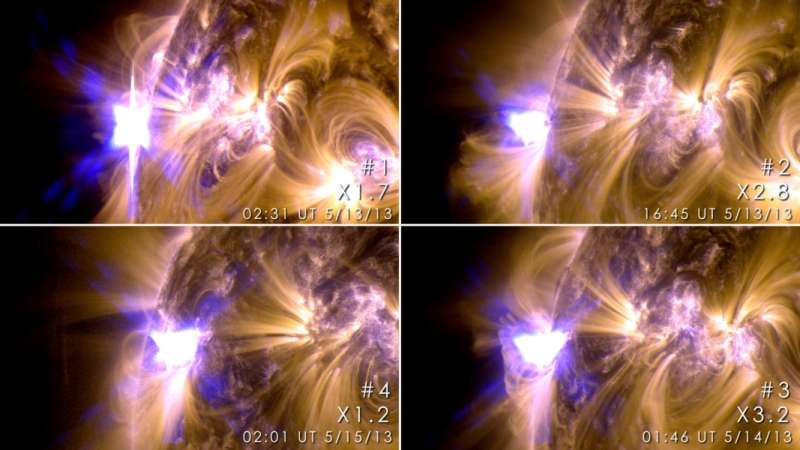Credit & Copyright: NASA,
Solar Dynamics Observatory, GSFC
Explanation:
Swinging around the Sun's eastern limb on Monday,
a group of sunspots labeled active region AR1748 has produced the
first four X-class solar flares of 2013
in less than 48 hours.
In time sequence clockwise from the top left,
flashes from the four were captured in extreme ultraviolet images
from the Solar Dynamics Observatory.
Ranked
according
to their peak brightness in X-rays, X-class flares
are the most powerful class and are frequently accompanied by
coronal
mass ejections (CMEs),
massive clouds of high energy plasma launched into space.
But CMEs from the first three flares were not Earth-directed,
while one associated with the fourth flare may deliver a
glancing blow to the
Earth's magnetic field
on May 18.
Also causing temporary radio blackouts, AR1748 is likely not finished.
Still forecast
to have a
significant chance
of producing
strong flares, the active region is rotating
into more direct view
across the Sun's nearside.
1999 2000 2001 2002 2003 2004 2005 2006 2007 2008 2009 2010 2011 2012 2013 2014 2015 2016 2017 2018 2019 2020 2021 2022 2023 2024 2025 |
Yanvar' Fevral' Mart Aprel' Mai Iyun' Iyul' Avgust Sentyabr' Oktyabr' Noyabr' Dekabr' |
NASA Web Site Statements, Warnings, and Disclaimers
NASA Official: Jay Norris. Specific rights apply.
A service of: LHEA at NASA / GSFC
& Michigan Tech. U.
|
Publikacii s klyuchevymi slovami:
solar flare - Solnechnaya vspyshka
Publikacii so slovami: solar flare - Solnechnaya vspyshka | |
Sm. takzhe:
Vse publikacii na tu zhe temu >> | |
